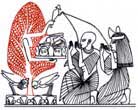|
Correcting
Common Misconceptions about Nonviolent Action
Gene Sharp
What nonviolent action is
Nonviolent action is
a generic term covering dozens of specific methods of protest, non-cooperation,
and intervention, in all of which the actionists conduct the conflict by
doing—or refusing to do—certain things without using physical violence. As a
technique, therefore, nonviolent action is not passive. It is not inaction. It
is action that is non-violent.
The issue at stake
will vary. Frequently it may be a political one—between political groups, for
or against a government, or, on rare occasions, between governments (as in
imposition of embargoes or resistance to occupation). It may also be economic or
social or religious. The scale and level of the conflict will also vary. It may
be limited to a neighborhood, a city, or a particular section of the society; it
may at other times range over a large area of a country or convulse a whole
nation. Less often, more than one country and government may be involved.
Whatever the issue, however, and whatever the scale of the conflict, nonviolent
action is a technique by which people who reject passivity and submission, and
who see struggle as essential, can wage their conflict without violence.
Nonviolent action is not an attempt to avoid or ignore conflict. It is one
response to the problem of how to act in politics, especially how to wield power
effectively.
What nonviolent action is
not
- Nonviolent
action has nothing to do with passivity, submissiveness, and cowardice; just
as in violent action, these must first be rejected and overcome.
- Nonviolent
action is not be equated with verbal or purely psychological persuasion,
although it may use action to induce psychological pressures for attitude
change; nonviolent action, instead of words, is a sanction and a technique
of struggle involving the use of social, economic, and political power, and
the matching of forces in conflict.
- Nonviolent
action does not depend on the assumption that people are inherently
‘good’; the potentialities of people for both ‘good’ and ‘evil’
are recognized, including the extremes of cruelty and inhumanity.
- People
using nonviolent action do not have to be pacifists or saints; nonviolent
action has been predominantly and successfully practiced by ‘ordinary’
people.
- Success
with nonviolent action does not require (thought it may be helped by) shared
standards and principles, a high degree of community of interest, or a high
degree of psychological closeness between the contending groups; this is
because when efforts to produce voluntary change fail, coercive nonviolent
measures may be employed.
- Nonviolent
action is at least as much of a Western phenomenon as an Eastern one;
indeed, it is probably more Western, if one takes into account the
widespread use of strikes and boycotts in the labor movement and the
non-cooperation struggles of subordinated nationalities.
- In
nonviolent action there is no assumption that the opponent will refrain from
using violence against nonviolent actionists; the technique is designed to
operate against violence when necessary.
- There
is nothing in nonviolent action to prevent it from being used for both
‘good’ and ‘bad’ causes, although the social consequences of its use
for a ‘bad’ cause may differ considerably from the consequences of
violence used for the same cause.
- Nonviolent
action is not limited to domestic conflicts within a democratic system; it
has been widely used against dictatorial regimes, foreign occupations, and
even against totalitarian systems.
- Nonviolent
action does not always take longer to produce victory than violent struggle
would. In a variety of cases, nonviolent struggle has won objectives in a
very short time—in as little as a few days. The time taken to achieve
victory depends on diverse factors—primarily on the strength of the
nonviolent actionists.
*** *** ***
| |
|

|
Front Page
|
|
Spiritual Traditions
|
Mythology
|
Perennial Ethics
|
Spotlights
|
Epistemology
|
Alternative Medicine
|
Deep Ecology
|
Depth Psychology
|
Nonviolence &
Resistance
|
Literature
|
Books & Readings
|
Art
|
On the Lookout
|

|
|